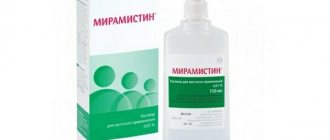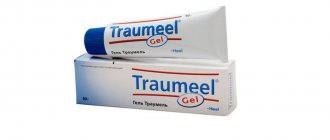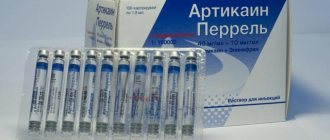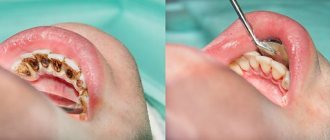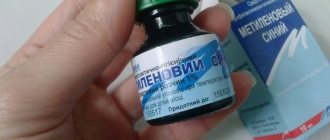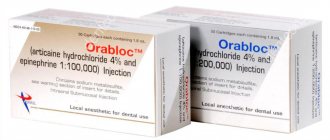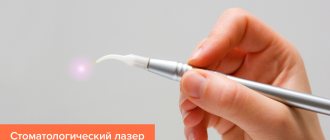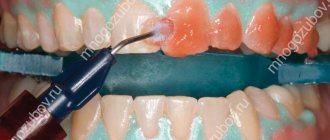Sometimes a person’s life depends on how correctly first aid was provided. Many of us have encountered small cuts in everyday life, abrasions on children, or wounds from pricks from a branch. However, few people have thought about what consequences could happen if a deep cut is not treated and stitched up in time or if you do not seek medical help if you receive a laceration. It is in critical situations that a person is often lost and does not know how to properly provide first aid, or what to do if an open wound is bleeding heavily, and the nearest first aid station is several tens of kilometers away. When human life is at stake, there is no time to study medical instructions, so it is better to know in advance how to act correctly.
Pharmacological properties
Pharmacodynamics.
The active substance of the drug is miramistin, a cationic surfactant with an antimicrobial (antiseptic) effect.
The action is based on the direct hydrophobic interaction of the miramistin molecule with the lipids of the membranes of microorganisms, leading to their fragmentation and destruction.
It has a pronounced antimicrobial effect against gram-positive (Staphylococcus spp., Streptococcus spp., Streptococcus pneumonia) and gram-negative, aerobic and anaerobic bacteria, spore-forming and asporogenous bacteria in the form of monocultures and microbial associations, including hospital strains with multidrug resistance to antibiotics. Reveals an antifungal effect on ascomycetes (genus Aspergillus and genus Penicillium), yeast (Rhodotorula-rubra, Torulopsis gabrata) and yeast-like fungi (Candida albicans, Candida tropicalis, Candida krusei), dermatophytes (Trichophyton rubrum, Trichophyton mentagrophytes, Trichophyton verrucosum, Trichophyton schoenle ini, Trichophyton violacent, Epidermophyton Kaufman-Wolf, Epidermophyton floccosum, Microsporum gypseum, Microsporum canis), as well as other pathogenic fungi (for example, Pityrosporum orbiculare (Malassezia furfur)), in the form of monocultures and microbial associations, including fungal microflora with resistance to chemotherapeutic drugs means. Under the influence of miramistin, the resistance of microorganisms to antibiotics decreases.
At the site of application, it activates regeneration processes.
Thanks to its broad spectrum of antimicrobial action, miramistin effectively prevents infection of wounds and burns. The drug has pronounced hyperosmolar activity, as a result of which it stops wound and perifocal inflammation, absorbs purulent exudate and selectively dehydrates necrotic tissue, promoting the formation of a dry scab. At the same time, the ointment does not damage granulations and viable skin cells, and does not inhibit marginal epithelization.
Pharmacokinetics.
Due to the physicochemical properties of the ointment base, the drug acts not only on the superficial wound microflora, but also on pathogens located in the tissues surrounding the wound, which is why it is possible that a small part of Miramistin may enter the systemic bloodstream.
Miramistin: reviews
There are both positive and negative reviews on Miramistin. But if you take a closer look at the latter, most of them are associated exclusively with improper use of the drug. Moreover, this is partly the fault of the manufacturer, who deliberately does not indicate in the instructions for the drug how long you need to rinse your mouth or throat with it.
You will certainly get a good effect from Miramistin if you rinse your mouth or throat with it - 3-4 times a day for 2-3 minutes. Not all patients are able to endure such a time (and this is especially impossible when gargling in children), but keep in mind that the minimum duration of each gargle should be at least 1 minute. And remember that after rinsing/irrigating with miramistin, this antiseptic is very quickly washed off with saliva, and therefore its effectiveness will directly depend on the time of contact with inflamed tissues (for example, tonsils or foci of stomatitis on the mucous membrane).
Advantages of Miramistin -
1) Good antimicrobial activity “in vitro”, i.e. in vitro (effective against most pathogenic bacteria, both gram-positive and gram-negative, viruses, as well as fungal flora). And remember that to achieve good clinical effectiveness (in vivo), it is advisable to ensure longer contact of the antiseptic with the inflamed tissues. That is, if we should rinse our mouths with chlorhexidine only 2 times a day for 1 minute, then with Miramistin we should rinse our mouths more often and for longer.
2) It acts on herpes viruses of types 1-2, making this remedy the best option for rinsing for stomatitis. In addition, it is the only antiseptic that is effective against many viruses that cause ARVI, and therefore it is the main drug for the treatment of acute tonsillitis (but not chronic!), as well as acute/chronic pharyngitis and laryngitis.
3) It has a spray nozzle, which facilitates the treatment of tonsils with tonsillitis, as well as foci of stomatitis and other foci of inflammation in the oral mucosa - in young children (who cannot yet rinse their mouth or throat themselves). The spray attachment is also great for treating skin wounds.
4) It has a neutral taste, which is especially important for young children (for example, chlorhexidine will have a slightly bitter taste).
5) Increases local immunity of the oral mucosa (due to activation of the absorption capacity of phagocytes), and also helps to accelerate the epithelization of erosions and ulcers on the oral mucosa.
Disadvantages of the drug -
1) Do not use for longer than 10 days (as in principle other antiseptics).
2) The price for Miramistin is quite high, especially when you compare its cost with chlorhexidine. Miramistin costs about 450 rubles per 150 ml, and the latter costs about 20 rubles per 100 ml bottle (0.05% concentration). If we compare 500 ml bottles of these drugs, Miramistin will cost about 850 rubles, and 0.2% chlorhexidine will cost about 400 rubles.
Indications
Surgery, traumatology:
local treatment of infected wounds of different locations and etiologies, prevention of secondary infection of granulating wounds.
Combustiology:
treatment of burns of II and III A degrees; preparation of burn wounds for dermatoplasty.
Dermatology:
strepto-, staphyloderma, dermatomycosis of smooth skin, feet and large folds (including dyshidrotic forms and forms complicated by pyoderma), nails (onychomycosis), keratomycosis (including pityriasis versicolor), candidiasis of the skin and mucous membranes.
Prevention of complications of wound infection - in case of minor industrial and domestic injuries.
Treatment of cuts
Unfortunately, most often the treatment of cuts comes down to simply rinsing with water or applying a handy bandage directly to the wound. This method of treatment is not applicable even if the cuts on the hands are less than 1 cm. Normal wound healing, without complications and suppuration, is only possible if the wound is clean, treated with an antiseptic solution and protected with a sterile bandage.
If a deep wound is handled carelessly, a process of suppuration may occur, which will negatively affect the entire body. The most dangerous are closed purulent wounds; in this case, purulent exudate has no outlet and causes intoxication. In such cases, urgent surgical intervention and general drug treatment are required to help the patient cope with intoxication of the body.
‹ Fungus in the pool and sauna Up Sexually transmitted infections (STDs) ›
Application Features
The effectiveness of the drug increases if the ointment is applied to the wound surface, previously washed with an aseptic solution.
The presence of purulent-necrotic masses in the wound requires additional use of ointment.
Use during pregnancy or breastfeeding.
Due to the lack of sufficient experience, you should consult your doctor before using the drug during pregnancy or breastfeeding.
The ability to influence the reaction rate when driving vehicles or other mechanisms.
The drug does not affect the reaction rate when driving vehicles or other mechanisms.
Miramistin during pregnancy
Miramistin instructions for pregnancy and breastfeeding indicate the complete safety of the drug in this group of patients. Those. You can absolutely safely use Miramistin during pregnancy and breastfeeding - for rinsing the mouth, because the drug has only superficial activity and is not absorbed at all through the mucous membrane.
The only condition for use in pregnant and lactating women is that the drug should not be swallowed. Therefore, if you use a spray form (for example, to irrigate the throat or tonsils), then it is advisable to then spit out all the liquid that is in the mouth. We hope that our article on the topic: Miramistin - instructions for use, price - was useful to you!
Sources:
1. Add. professional
, 2. Personal experience as a dental surgeon, periodontist, 3. “Therapeutic dentistry. Textbook" (Borovsky E.V.), 4. https://miramistin.ru.
Directions for use and doses
The drug should be used topically for adults.
Treatment of wounds and burns.
After standard treatment of wounds and burns, apply the medicine directly to the affected surface, then apply a sterile gauze bandage or apply ointment to the dressing material and then to the wound.
You can also use tampons soaked in the drug, carefully filling the cavities of purulent wounds after surgical treatment, or gauze turundas with ointment, introducing them into the fistula tracts.
Use the drug once a day in the treatment of purulent wounds and burns in the 1st phase of the wound process and once every 1–3 days in the 2nd phase, depending on the condition of the wound. The dose depends on the area of the wound surface and the degree of purulent exudation. The duration of treatment is determined by the dynamics of wound cleansing and healing. If the infection is deeply localized in the soft tissues, it is possible to use the drug together with systemic antibiotics, and the duration of treatment will be determined by the duration of the antibiotic course.
Treatment of dermatological diseases.
Apply the medicine in a thin layer to the damaged areas of the skin or apply the ointment to the dressing material, and then to the lesion 1-2 times a day. Duration of treatment: use the drug until negative results of microbiological control are obtained. For common dermatomycosis, in particular rubromycosis, the ointment can be used for 5–6 weeks in complex therapy with griseofulvin or systemic antifungal drugs. For fungal nail infections, the nail plates should be peeled off before starting treatment.
Children.
Due to the lack of sufficient experience, the drug should not be used in pediatric practice.
First aid for wounds and cuts
Wounds and cuts are considered the most common types of skin injuries. A cut on your finger, abrasions on your knees are a constant picture of growing up. The cause of a cut can be a common object - scissors or a knife, a piece of glass in the yard, a rusty nail or a wood chip. The deeper the skin cut, the more difficult the recovery will be. In order for cuts to heal quickly, in some cases it is necessary not only timely treatment of the wound, but also stitches, which can only be applied by a specialist directly in a medical institution. Thus, treatment of cuts begins not in a hospital or clinic, but with first aid to the victim.
Help for cuts, punctures and lacerations begins with assessing the situation: how severe the bleeding is, what color the blood is (dark - venous; scarlet, pulsating - arterial), the presence of a foreign body in the wound, contamination of the wound with earth, sand. If the bleeding is strong and pulsating, this should alert you. This means the artery is damaged; you need to stop the bleeding by applying a tourniquet to the limbs above the wound. Afterwards, carefully examine the wound for the presence of fragments or other objects. To prevent infections, even a shallow wound should be washed with clean water and treated with the drug Miramistin.
Miramistin® is a modern generation antiseptic drug that exhibits high activity against bacteria, viruses, protozoa and fungi, including various microbial associations.
The drug enhances the process of tissue regeneration and increases local protective reactions at the site of inflammation. After hygienic treatment (rinsing with water), it is necessary to rinse the wound with Miramistin® to avoid infection.
Even a deep cut on the finger that can be caused by cooking should be treated with an antifungal and antibacterial medication to avoid infection.
Overdose
No overdose phenomena were observed. However, when applying the drug to large surfaces of the affected skin, the possibility of partial penetration of the active components of the ointment into the systemic bloodstream in quantities not capable of causing acute poisoning cannot be excluded. The systemic effect of miramistin manifests itself as the action of a cationic detergent and can prolong bleeding time.
Treatment: dose reduction or discontinuation of the drug, administration of oral calcium supplements, Vikasol.

